
Background information
Fairphone 3: Review superfluous
by Dominik Bärlocher
Why does the iPhone 11 Pro Max have a double camera bump? My teardown won't completely answer this question, more propose a theory: Apple is getting people ready for the iPhone 12.
Apple's iPhone 11 caused many a stir with one design aspect in particular: the double camera bump. The back contains an elevation in which the cameras are embedded. Practically every smartphone has this. The so-called camera bump makes it easier for users to pick up the phone and prevents you from accidentally bumping your fingers on the lenses.
But Apple has added an extra bump per lens with the iPhone 11. Strange. Apple always makes a big effort with the design of its devices. Both fans and cynics argue that part of the high price of Apple devices is their beautiful design. And anyone who has heard ex-Apple chief designer Jony Ive talk about the ideas behind their design knows: Apple leaves nothing to chance when it comes to design.
Nice! Simple. Making the complex devilishly basic. These are Ive's principles. Apple is still taking this into account, even after Ive's departure in November 2019. These ideas are just too good, too efficient and – after all radii have been measured and all colour palettes defined – too financially successful.
So why does the iPhone 11 have something as ugly as the Double Camera Bump? Time for a teardown. After all is said and done, only one question and assumption will remain: what will Apple do with its cameras in the near future?
Apple's smartphones are the most water-proof on the market. This knowledge alone makes my teardown harder. The more waterproof a phone is, the more difficult it is to penetrate without causing great damage. The iPhone 11 has an IP rating of IP 68, but that's an understatement. IP 68 denotes that a device can survive for 30 minutes a metre below water. But Apple built the iPhone 11 to last 30 minutes at a depth of 4 metres.
The first signs of this can be seen when loosening the two screws next to the charging port. They are classic Apple proprietary screws, fairly easy to unscrew with an iFixit toolkit. The screw thread is additionally filled with an adhesive mass, which should prevent any water penetration. This is exactly where Apple starts to shine. It is this attention to every small detail that ultimately makes the iPhone such a beautiful device. My teardown not only confirms this, it also increases my admiration for Apple's engineering.
Even with these two screws loosened, the unit won't fall apart just yet. Like most smartphones, the iPhone 11 Pro Max is divided into two parts on the outside. The front has the screen, the back a kind of base in which all the technology is housed. The two elements are glued together, one of the major criticisms of Right to Repair supporters. It's almost impossible to get the waterproof seal back to the way it was once the unit is open. And Apple doesn't mess around with its black glue (article in German).
To get inside an iPhone, you need a hot air dryer and a thin but blunt blade. Some warnings:
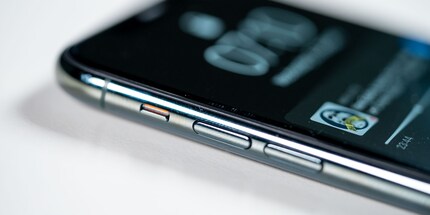
As soon as you have blow-dried the iPhone from a distance of about 20cm for about half a minute, you can press a suction cup onto the screen, grab the edges of the phone with your fingers – attention, hot – and pull the device apart a little. Cautiously. You will quickly see if and where the display can be detached from the back plate. If nothing's happening, just apply more hot air.
When there's enough space between back plate and screen, you can enter the gap with the blade. This helps, making the hot air dryer work easier, as you can loosen the softened glue akin to using a letter opener. But constant vigilance is required, you're very close to very sensitive electronics. Apple, just like all other smartphone manufacturers, keeps only the outer shell robust. Although everything on the inside is solidly built, the parts are far from being as tough as the screen or the back plate.
Then, once you've loosened the top, bottom and left sides, you can simply unfold the iPhone.
A sight that makes me just love the iPhone. The tech buff in me is ecstatic. No other phone has guts as beautifully built as the iPhone. It's definitely more beautiful from the inside than from the outside.
Most of the inner workings are determined by the battery. Apple shrunken it whatsoever, even making the iPhone a little thicker than last year. While the iPhone XS Max was 7.7 mm thick, the iPhone 11 Pro Max is 8.1mm thick. Apple has used this to increase battery power, among other things.
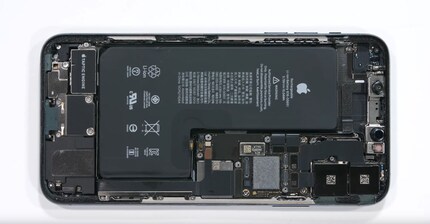
There's one thing you need to know about smartphones. Every bit of space is infinitely valuable. This is also what leads me to a conclusion on the cameras. Hardly any other device is as packed with technology as a smartphone. One millimetre contains worlds of possibilities. As expected, the iPhone's insides are teeming with special connectors and proprietary looking cable connections. The iPhone doesn't resemble any other phone, except that the battery dominates the interior. In general, a large part of the weight of a smartphone is the battery.
The microphone and loudspeaker arrays are installed at the upper and lower edges. Plus the Apple Taptic Engine, the iPhone's vibration motor.
And crammed into the corner, most of the actual iPhone itself. The component that brings everything into line: the mainboard. On it are the so-called Lego connectors, which connect the components with the mainboard by cables. This shows how limited the space is. Lego connectors are layered, so there's one connector below the other. But again: outstanding move.
There seems to be no end to the Double Camera Bump riddle. And here's where we encounter the most frustrating aspect of the iPhone 11 Pro Max. I can loosen most screws with a Y000 screwdriver. Except for those that need a 000-cross-head screwdriver. That's three types of screw I've encountered so far. A fourth type awaits later: the double-screw screw. You can loosen them with a flat screwdriver. I understand the fourth type, but not why Apple needed three other types. Wouldn't it have been easier to do everything with Torx? It's not as if Torx doesn't have small sizes. At 1.42mm, the Torx T5 is even slightly smaller than a Phillips screwdriver or a Y000, both 1.5mm.
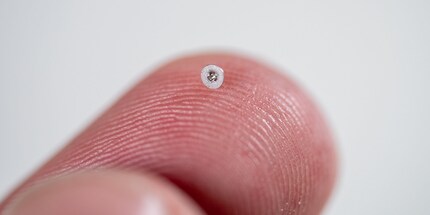
If you want to repair the iPhone, I strongly recommend you somehow store the loosened screws so that you can track where you unscrewed them. Otherwise, you'll end up in a lot of trouble. In the name of the Right to Repair, it would be nice if Apple committed itself to one type of screwdriver, then the repair of an iPhone would be much easier.
It's getting spicy. After the Selfie Cam is removed, I have free access to the camera system, including the Double Camera Bump. I already notice one thing during disassembly. The first camera bump contains a rather clumsy frame.
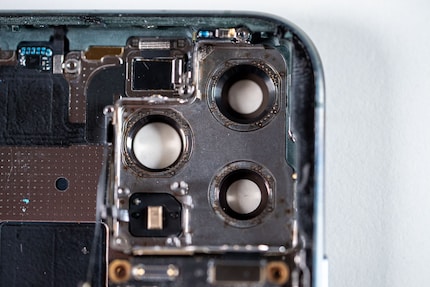
It doesn't really fit into the whole design of the iPhone. Clumsy, seems anything but intended and frighteningly rough. Until now, the iPhone has been a masterpiece of filigree and deliberate design. And now this metal thing. Why? If it was removed, the iPhone wouldn't only be lighter, but also slimmer. Apple could have saved the space.
Unless Apple doesn't want to save space. But Apple doesn't do anything randomly.
The big useless lump of metal in the lower camera bump is indicative of one thing: Apple is creating room. The company has a history of reusing outer shells. The iPhone X and its successor, the XS, have exactly the same dimensions. The XS is more waterproof than the X. If we now assume that the iPhone 12 will have exactly the same case as the iPhone 11, then Apple has a millimetre or more space at the top of the camera.
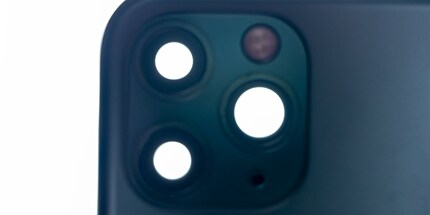
Now, how to fill out this extra space?
The development of a smartphone, from the drawing board to market launch, takes about two years. Developing the underlying technology often takes longer. These are rules of thumb that the analyst scene works with, but they're controversial. Some say it takes longer, others suspect a much more spontaneous approach. I myself accused Sony of quite spontaneous behaviour when I thought about the marketing and industrial truth behind the Sony Xperia 1.
In broad terms, the look of the iPhone 12 could already have been decided during early development of the 11 model. Using similar logic, it's possible that the iPhone 11 has given in to the design ideas of the iPhone 12 and the second camera bump is currently not yet of any use, as the space will only become relevant later this year.
The question now, however, is what they'll pack into the space created by removing or narrowing the blocky frame. A look into the rumour mill and the words of analyst Ming Chi Kuo, whose hit rate is astonishingly high, shows that he expects a Time of Flight camera (ToF), dated July 2019. Including 5G chips, but they'll probably be placed into the mainboard. A ToF camera measures distances in pictures, helping to get faster and more beautiful depth of field and 3D effects. This would mean a dramatic improvement in the performance of the iPhone camera. Ming Chi Kuo confirms this assumption in another publication from December 2019.
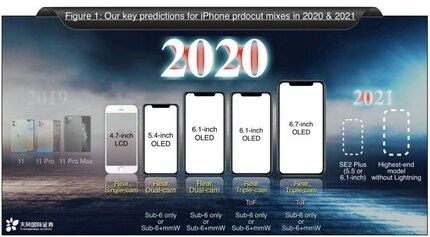
Malcolm Owen of Apple magazine AppleInsider discovered that Apple is working on a camera system that stacks three to five camera lenses on top of each other. In a patent entitled «Folded lens system with five refractive lenses» and its smaller sibling «Folded lens system with three refractive lenses», two camera systems which are radically different from the lenses currently used in a smartphone can be seen – and not only regarding the iPhone. The sensor would no longer be installed in the camera system flat, i.e. parallel to the screen, but at right angles. A prism would then let the light from outside penetrate inside, where three or five lenses manipulate the resulting image.
The five-camera setup should be equivalent to a 50-85mm lens, with a field of view of 28 to 41 degrees. According to Malcolm Owen, this is supposed to be good for wide-angle photography. Meanwhile, the three cameras are to be equivalent to 80-200mm lenses, having a field of view of 17.8 to 28.5 degrees. Owen thinks that this could be a telephoto lens. AppleInsider even goes one step further and says that this new lens architecture could dramatically reduce the camera bump.
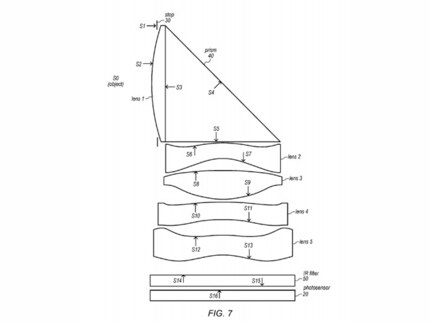
Apple could now incorporate these two systems and a third one, not needing a new patent, into an iPhone 12. But patents are one thing: Just because they're registered doesn't mean that they'll actually become real one day. But patents indicate the research areas in which Apple is currently investing resources.
Combined with the ugly metal piece inside the iPhone 11 Pro Max, a few lines can be added to the sketch of Apple's future.
Journalist. Author. Hacker. A storyteller searching for boundaries, secrets and taboos – putting the world to paper. Not because I can but because I can’t not.
Interesting facts about products, behind-the-scenes looks at manufacturers and deep-dives on interesting people.
Show all